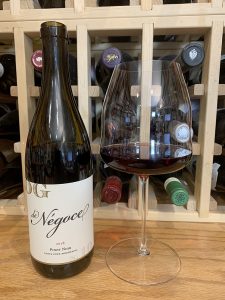Pale ruby color; cherry, raspberry, spice on the nose; cherry, raspberry, cola, oak, vanilla on the palate.

Dry; light almost ethereal body; relaxed, dusty tannins; gentle acidity. Delicious fruit. de Négoce deliberately does not tell you much—more about that in this review—but did reveal lightly toasted French oak. Sourced from Santa Cruz Mountains vineyard above 2,000 feet, contributing to diurnal shift, a key ingredient in quality wine. 14.5% ABV
Through the de Négoce program, this costs about $12 a bottle (when you buy the required case). It costs about $50 a bottle when purchased from the originating winery.
As the name implies, de Négoce is a négociant operation. In this case, it means de Négoce (French for “of trade”) makes no wine but puts their label on a bottle and sells it. When de Négoce claims this wine sells for $50-plus from its maker, I think that is reasonable. Using de Négoce’s system, it will cost you less than $15. Reviewing such wines is not something I typically do, but this system and these wines have been worth exploring and telling you about. This is the third de Négoce wine I have tried, and all have been good wines.
Here is how the de Négoce system works:
• Cameron Hughes, a veteran négociant, only sells directly to the consumer through his Phoenix Wine Company.
• You join his “Wine Futures List” to be notified of new releases of special wines Hughes finds.
• Instead of bottling and cellaring wines, Hughes sells the wine, then bottles it and ships it.
• You cellar the wine for several months—I have done so with the selections he sent me—to allow the bottle to recover from “bottle shock” and come around to present its best self. This is a task typically done by the winery. In this system, it is done by you.
There are cautionary details to keep in mind:
• You are required to buy in six-bottle or 12-bottle lots.
• You are, in most cases, buying wine and then waiting for delivery. Hughes buys some wines in barrel and then bottles. He acquires others that are offered as they come off the bottling line. Barreled wines take 6-12 weeks to ship. Bottled wines usually take 3-6 weeks to ship. He ships only when weather permits, so expect a hold in summer
• Since all the wines are recently bottled, they need time to rest after you get them. Bold, tannic cabs need 3-8 months. Medium-bodied reds like pinot noir and zinfandel, 2-3 months. Medium-to-full-bodied whites need at least two months and add complexity and bouquet when you wait six months. Light-body whites can be ready in 6-8 weeks, but they, too, benefit with more patience.
• The source wine usually is anonymous, so information about the wine is limited.
Here is how the company presents its case: “Ready for a secret? Wine does not cost a lot to make, it costs a lot to sell. Since the end of Prohibition, layer-upon-layer of government-mandated middlemen and cumbersome state-by-state distribution policies have created the world’s most inefficient wine market. Only in the USA does a wine that costs $10 to produce end up costing you $50.
“Enter de Négoce. With 20+ years of global wine sourcing experience, we have become the #1 direct-to-consumer wine brand in the country in just one year of business. How? We source excess exceptional wine from icon and boutique wineries and sell it directly to you at incredible prices. Simple. Here is our promise: buy direct from de Négoce, cut out the middlemen, and you will save 60-80% off traditional retail prices. We guarantee every wine we sell so you can buy with confidence.”
This system is not for everybody. You will get quality wines, but you have to take on several of the responsibilities of the winery and the middlemen. The concept, however, is intriguing for the right person. Wine Enthusiast Magazine wrote: “It is one of the great mysteries of the universe how négociant Cameron Hughes produces wines like this at such a great price.”
